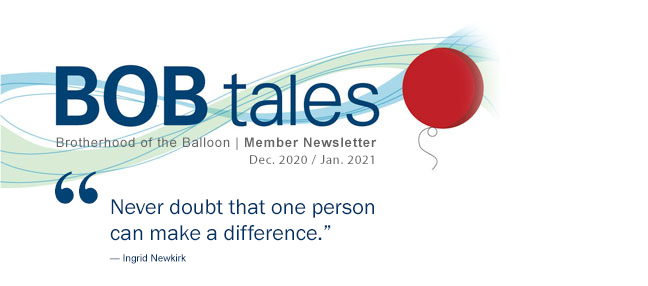
Dear Members (a note from Deb Hickey):
It’s been 20 years.
---------------------------
It was early September 2000. We’d finalized the floral arrangements – tropical bouquets in oranges, reds, and plums. I’d had my last dress fitting. We’d organized gifts for our wedding party and hired a local R&B/doo-wop band to play at the reception. The hors d’oeuvres tasting was the highlight – spring pea bruschetta and fried mac and cheese lollipops! And of course, the cake – we settled on vanilla, but the three tiers, each adorned with fresh flowers, and the decadent buttercream icing made it anything but basic.
Everything was as it should be … until it wasn’t.
I remember exactly where I was when he told me – at work, I’d just gotten up to stretch my legs. I remember what I was wearing and what color my office walls were.
“I have prostate cancer,” my father said to me over the phone. I felt my face go pale and I reached out and grabbed the edge of my desk to steady myself. But before I could respond, he continued, “but, it’s no big deal because I’ve found the best treatment in the world and I’m going to be fine.”
It’s just like my dad to make anything sound like a non-issue – a flat tire, a root canal … cancer. His goal in life was to take care of his family – never let them worry about a thing … and never ever let on that he wasn’t “okay.” I don’t know if it was pure selflessness or the fact that he felt it was the man’s inescapable and compulsory role to be the family leader – strong, capable … unbreakable. Maybe it was a little bit of both. Regardless, Dad was the eternal protector and problem-solver. He could do anything. Fix anything. At least that’s what I’d thought for 27 years up until that moment.
Immediately, thoughts of life without my dad flooded my mind and I got that sinking feeling in my stomach. I felt light-headed and slightly hearing-impaired. I realized after what must have been about a minute, my dad was still talking; the sound of his voice became louder as if someone was slowly turning up the volume. “… I’ve done my research – this is the very best treatment option for me and I’m going to be around a long time.” In his typical reassuring tone, Dad was comforting me.
For the next few weeks as I prepared for my big day, I’d reason with myself every time the thought of losing my father would cross my thoughts: If anyone is going to take care of the situation, it’s Dad. He knows what he’s doing. He’d never leave us.
And shortly thereafter – on a beautiful, spring-like day in October, he was holding my hand and walking me down the aisle.
A couple of weeks later, Dad and Mom left for California where they’d spend the next two months while my father underwent proton therapy at Loma Linda University Cancer Center. And I held my breath …
---------------------------
It’s been 20 years. Most of you know how this story ends.
Treatment was successful. And what began as an offer to coordinate communications between a small group of fellow patients after their treatments have ended has become a 10,000-member international support group. About 240 newsletters, two books, dozens of speaking engagements, and a handful of radio and TV interviews later, Bob Marckini has become a household name in the proton therapy world. He’s helped countless men cipher through the many prostate cancer treatment options; he’s counseled celebrities, dignitaries, high-profile businessmen, friends, neighbors, acquaintances, and strangers. He’s helped raise millions of dollars in funding for proton therapy research, has an endowed research chair in his name, and has received a Lifetime Achievement Award from the National Association for Proton Therapy. He even hired his daughter (that’s me) to help with this “ministry” we call the Brotherhood of the Balloon.
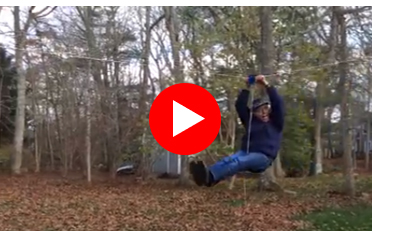 And he’s continued to be my unwavering protector and problem-solver. He’s also gained a grandchild and become the greatest papa I’d ever imagined. If you click the image to the left, you’ll see him testing out her Christmas gift. Not only has he built the safest and most extravagant backyard zip line known to man, but you’ll also see that he’s healthy, energetic … and a bit goofy. It must be the protons.
And he’s continued to be my unwavering protector and problem-solver. He’s also gained a grandchild and become the greatest papa I’d ever imagined. If you click the image to the left, you’ll see him testing out her Christmas gift. Not only has he built the safest and most extravagant backyard zip line known to man, but you’ll also see that he’s healthy, energetic … and a bit goofy. It must be the protons.
---------------------------
This is our two-month, end-of-year issue, and there are some exciting things going on in the world of genetic testing. One new test, taken just once, could determine a man’s likelihood of getting prostate cancer – by a little or a lot. A prostate cancer urine biopsy test has gotten a push forward by the FDA and it could forever change the standard of care for the better. Researchers have identified a genetic signature in localized prostate cancer that can predict early on whether the cancer is likely to spread to other parts of the body. Two prostate cancer drugs are being tested to see if they could fight the worst effects of COVID-19. And there’s a lot more.
We hope you enjoy this issue of BOB Tales and as always, we welcome and encourage your feedback. Please send an email to [email protected].
Deb Hickey
To print the BOB Tales newsletter or view the newsletter with a larger font size, click here for the PDF file.
In This Issue:
- New Genetic Test Could be the Ultimate in Early Detection
- FDA Approval Process Accelerated for Prostate Cancer Urine Biopsy Test
- Gene Signature Predicts Whether Prostate Cancer is Likely to Spread
- Two Drugs to Treat Prostate Cancer Could be Used to Fight Worst Effects of COVID-19
- A Healthful Diet Reduces Prostate Cancer Risk, New Study Shows
- Early Signs of Alzheimer’s Disease



New Genetic Test Could be the Ultimate in Early Detection
Scientists at the University of Southern California have identified several combinations of genes that could raise a man’s risk of getting prostate cancer. They’ve discovered specific changes in these genes, called single-nucleotide polymorphisms (SNPs), that can also determine if a man’s risk of getting prostate cancer is raised by a little, or a lot.
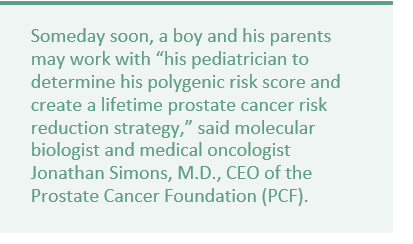 With the Smith Polygenic Risk Test for Prostate Cancer, patients can quickly and easily learn if they have a bad combination of genes. A cheek swab or a routine blood test done just once in the life of a man can identify a combination of more than 250 genetic variants that can determine prostate cancer risk.
With the Smith Polygenic Risk Test for Prostate Cancer, patients can quickly and easily learn if they have a bad combination of genes. A cheek swab or a routine blood test done just once in the life of a man can identify a combination of more than 250 genetic variants that can determine prostate cancer risk.
The major benefit of this test is that men who’ve been dealt a bad combination of genes can learn very early on if they need to be monitored closely for prostate cancer. They can get their PSA checked in their thirties and may consider having a lower PSA threshold – a lower cutoff number for PSA that would signal the need for further testing, including an MRI and a biopsy.
Another group of scientists is reviewing the test and hopes to confirm the results already found. They also plan to improve the risk stratification to ensure they’re looking at the right gene combinations for men of various races. When the test becomes widely available, it will assess different genetic profiles based on race.
Giving men a lifetime risk assessment and fine-tuning their prostate cancer screening, “is going to change everything,” says Simons.
Note: It’s important to understand that if you have a bad gene combination, it doesn’t necessarily mean you’re going to develop prostate cancer. Other factors – diabetes, obesity, smoking, or conversely, a healthful diet and exercise – play at least a small role, even in men at the very highest risk.
FDA Approval Process Accelerated for Prostate Cancer Urine Biopsy Test
miR Scientific, creators of the first standalone, non-invasive liquid biopsy urine test for prostate cancer, has received Breakthrough Device Designation by the FDA.
Products and/or devices qualify for this program when they “provide for more effective treatment or diagnosis of life-threatening or irreversibly debilitating diseases or conditions.” The program helps to speed up the development and/or assessment of these products while preserving the integrity of the FDA approvals process.
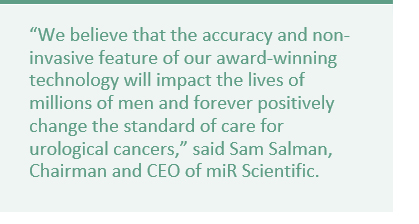 miR Scientific’s goal for the Sentinel™ Prostate Test is to make accurate cancer screening more widely available and non-invasive. Using molecules derived from urine, scientists can classify patients into four possible groups: no molecular evidence of prostate cancer; low-risk; intermediate-risk; or high-risk prostate cancer.
miR Scientific’s goal for the Sentinel™ Prostate Test is to make accurate cancer screening more widely available and non-invasive. Using molecules derived from urine, scientists can classify patients into four possible groups: no molecular evidence of prostate cancer; low-risk; intermediate-risk; or high-risk prostate cancer.
In comparison to other technologies, the specificity and sensitivity of this test could reduce mortality rates and decrease the number of hospitalizations, physician visits, and shorten recovery time, according to developers.
Gene Signature Predicts Whether Prostate Cancer is Likely to Spread
Researchers have identified a genetic signature in localized prostate cancer that can predict early on whether the cancer is likely to spread to other parts of the body. The gene signature may also help to evaluate treatment responses and be used to develop new therapies to prevent or treat advanced prostate cancer.
“If we could know in advance which patients will develop metastases, we could start treatments earlier and treat the cancer more aggressively,” says the study’s senior author, Cory Abate-Shen, PhD.
The gene signature is also useful in predicting disease in patients that’s likely to remain confined to the prostate thereby sparing patients unnecessary treatment.
Two Drugs to Treat Prostate Cancer Could be Used to Fight Worst Effects of COVID-19
Australian researchers working on two drugs to reduce the size of prostate cancer tumors realized the drugs may also prevent damaging inflammation caused by COVID-19. Many who die from coronavirus suffer acute respiratory distress syndrome (ARDS), a serious lung condition that causes uncontrolled inflammation.
“We were very excited to pivot when calls for helping to address COVID came about, because we could see these drugs would have a very strong impact on ARDS, which comes about through the same pathways we’ve been targeting,” said Colleen Nelson, founder and executive director of the Australian Prostate Cancer Research Center in Queensland.
The drugs to treat prostate cancer target hormones secreted from fats in the body that are involved in inflammation. “One of the hormones is inflammatory and one is anti-inflammatory, and so we’ll be using the drugs to modify inflammation, which is the underlying issue in ARDS,” said researcher, Dr. Lisa Philip. “Basically, the body’s own immune response attacks the tissues in the lung and we’re hoping that these two novel therapies could reduce the inflammation in the lung and prevent ARDS.”
ARDS also ooccurs in patients with the flu, typically killing 3 million patients a year, so these two drugs have bigger implications than just COVID-19.



We’ve been producing BOB Tales newsletters monthly for 20 years. During this time there have been articles that many new members haven’t seen, and some older stories members may have forgotten. So, we periodically re-run articles from past newsletters. Following are excerpts from an article written by Bob Marckini in our April 2006 newsletter titled:
“… Go Where There is No Path and Leave a Trail.”
About a hundred years ago, a prominent individual in Southern California said, “These Seventh-day Adventists have about as much of a chance to create a medical facility in Loma Linda as building a railroad to the moon.”
Well, today, one of the finest teaching hospitals in the world sits in Loma Linda, CA. Loma Linda University Health (LLUH) is an internationally known, advanced technology university and major medical and trauma center in Southern California, the infant heart transplant capital of the world, and it has earned countless awards and honors. And, if we understand this statistic correctly, more Loma Linda University graduates are serving as medical missionaries around the world than all other teaching hospitals combined.
A Particle Accelerator in a Hospital?!
Similar doubts were expressed when a visionary physicist/radiation oncologist by the name of James M. Slater proposed to build the first hospital-based proton treatment facility in the world. He was greatly troubled by the collateral damage his patients were experiencing when treated with conventional radiation. As a physicist, he knew that proton beam radiotherapy was far more precise and should result in improved disease control and fewer side effects. So, he proposed to design and build a particle accelerator and proton treatment center in a hospital setting.
One newspaper critic called the project a “boondoggle” and a “white elephant.” Today more than 11,000 patients have been treated there (Update 2020: plus tens of thousands more); four new proton facilities have followed (Update 2020: 35 more in the U.S. and 86 worldwide); and many more are in the design or development stages, all because of Dr. Slater’s courage and pioneering leadership.
Ralph Waldo Emerson’s famous quotation certainly applies to both of these extraordinary accomplishments: “Do not go where the path may lead, go instead where there is no path and leave a trail.”
Looks like that “Railroad to the Moon” and the “boondoggle” project were quite successful.
We BOB members have been the beneficiaries of these bold crusades and we have an opportunity to say “thank you” by giving something back to the institution that, for the vast majority of us, saved our lives and preserved the quality of our lives. This applies to those treated at Loma Linda as well as other proton centers that followed Loma Linda’s lead.
Pauline and I contribute to Loma Linda every year as a way of saying, “thank you,” and we have remembered Loma Linda in our estate plan. I encourage each of you to consider doing the same. Many have already done so.
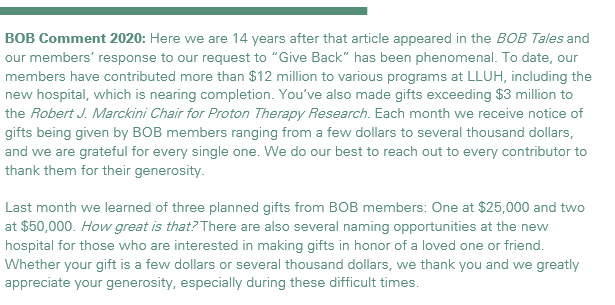
Ho w to Give
w to Give
- Donate online.
- Write a check to LLUCC Proton (Put “Marckini Chair” on the memo line) and mail to LLUH, Office of Philanthropy P.O. Box 2000, Loma Linda, CA 92354. Or make an unrestricted gift (put “unrestricted” on memo line) so LLUH can use it where it’s needed most.
- Donate online to other areas of need at LLUH.
- Call Regina Joseph at 909-558-5010 to donate over the phone and/or to inquire about naming opportunities.


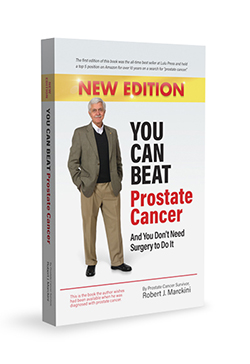 You Can Beat Prostate Cancer: And You Don’t Need Surgery to Do It – Second Edition
You Can Beat Prostate Cancer: And You Don’t Need Surgery to Do It – Second Edition
We continue to hear from readers that they had no idea how little they knew about prostate cancer detection and treatment and how Bob’s new edition greatly influenced their treatment decision. Virtually everyone we’ve heard from has told us they’ve chosen proton therapy. Nothing makes us happier.
As of this writing, the new edition of Bob’s book is still in the No. 1 position on a search for “prostate cancer” on Amazon. All 44 reviews are 5-star.
Here’s an excerpt from a recent review from Alan:

Reliable and Authoritative: Ten years ago, the first edition of this book provided state-of-the-science information that led me to a prostate cancer cure - one of the most important decisions in my life. I’ve been cancer-free for more than a decade … This new edition is even more robust, providing the results of the most recent clinical and quality-of-life studies in easy-to-understand lay terms. Very readable and very personal.
Several prominent physicians and business professionals have endorsed the new edition. Following is an endorsement by Arnd Hallmeyer, MD, PhD, DSc, Prostate Cancer Survivor, Berlin, Germany:
This book has EVERYTHING you need to know about prostate cancer, even if you are not a prostate cancer patient but have been touched by this disease in some way. By reading this book you will learn how to deal with any serious illness and how to master your own health management. This new edition summarizes the feedback from many scientists, patients, and from the readership of Bob Marckini’s “BOB Tales Monthly Newsletter” during the past 20 years. This great book is an incredible resource for anyone seeking knowledge about serious health problems and a comprehensive manual on how to manage through them. The book is a “must read” and should be an important asset in everybody’s library.
If you’ve read Bob’s new book and have found it valuable, we encourage you to write a review on Amazon. This helps others learn critically important information about prostate cancer prevention, detection, treatment alternatives, and proton therapy.
Reminders!
The second edition of You Can Beat Prostate Cancer includes a complete update on prostate cancer prevention, imaging technology, diagnostic technology, treatment options, and virtually all aspects of the latest developments in proton therapy.
We’re happy to discount books in quantity (min. 20) to anyone interested in spreading the word on proton therapy. Just send an email to [email protected]. Proceeds from book sales are used to help fund our efforts and to support proton therapy research.
Please note: The Kindle version is free to Kindle Unlimited members or can be purchased for $9.99 for non-members.
The paperback price is $22.45
Buy You Can Beat Prostate Cancer second edition on Amazon or Lulu Press



Time of Day You Exercise May Lower Risk of Prostate Cancer
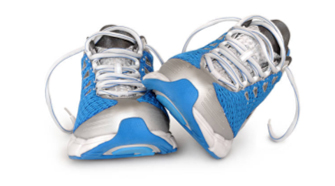 Physical activity of any intensity, whether folding laundry or jogging, can lower the risk of an early death for middle-aged and older people, a new study suggests. Furthermore, the time of day you move your body could affect risk further.
Physical activity of any intensity, whether folding laundry or jogging, can lower the risk of an early death for middle-aged and older people, a new study suggests. Furthermore, the time of day you move your body could affect risk further.
Researchers analyzed data from 2,795 participants. They identified a group of 781 women with breast cancer and 865 female controls, and a group of 504 men with prostate cancer and 645 male controls. Both groups responded to a questionnaire relating to their physical activities and gave data on the timing and frequency of their exercises.
The study found that exercising in the morning, between 8-10 a.m., showed the highest benefit in reducing the risk of both breast and prostate cancers. Researchers also found that men who exercised between the hours of 7 and 10 p.m. had a 25 percent lower risk of developing prostate cancer. No benefits from evening activity were seen in the group of women.
“Overall our findings indicate that time of the day of physical activity is an important aspect of physical activity that may potentiate the protective effect of physical activity on cancer risk,” the researchers wrote. “The effect of timing of physical activity on cancer risk should be examined in future research with a more detailed assessment of activity patterns, also including occupational activity.”
A Healthful Diet Reduces Prostate Cancer Risk, New Study Shows
Canadian researchers sought to corroborate the association between dietary patterns and prostate cancer risk, explaining the evidence on this issue thus far has been inconsistent. The study included 1,919 prostate cancer patients (median age, 64 years) and 1,991 controls (median age, 65 years).
Researchers administered a 63-item food frequency questionnaire during in-person interviews across seven years (2005 – 2012). They inquired about the frequency and portion size of foods consumed per day, week, and month. They included the consumption of coffee, tea, and alcohol. They also analyzed cooking methods.
Researchers identified three distinct eating patterns:
- Healthful Eating Pattern: high consumption of fruits, vegetables, tofu, soybeans, fish, brown bread, nuts or peanut butter, and yogurt and no consumption of white bread;
- Western Sweet and Beverages Pattern: high consumption of pasta, pizza, cookies, pastries, breakfast cereal, chips, ice cream, tomato or vegetable juice, milk, and carbonated soft drinks;
- Western Salty and Alcohol Pattern: high consumption of all types of meat, white bread, alcohol, and no consumption of brown bread, tofu or soybeans.
After adjusting for age, ethnicity, education, family history, and timing of last PSA screening, researchers used unconditional logistic regression to determine the association between dietary patterns and prostate cancer. They found an association between the healthful eating pattern and a decreased risk for overall prostate cancer. Conversely, the Western Sweet and Beverages Pattern was associated with a higher overall prostate cancer risk.
Researchers didn’t find an association between the Western Salty and Alcohol Pattern and prostate cancer risk. This suggests that specific dietary patterns may influence the development of prostate cancer more than others.
Early Signs of Alzheimer’s Disease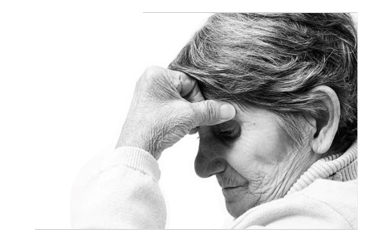
Alzheimer’s is one of the leading causes of declining health and death in the U.S., yet studies show the disease is widely misunderstood.
Alzheimer’s and Dementia: What’s the Difference?
Andrew Budson, professor of neurology at Boston University School of Medicine and author of the book, Seven Steps to Managing Your Memory, says that most people don’t know the difference between dementia and Alzheimer’s disease. According to the Alzheimer’s Association, “Dementia is the general term for a decline in mental ability severe enough to interfere with everyday life. Alzheimer’s Disease is a degenerative brain disorder that can lead to dementia.”
Adrianna Rodriguez is the reporter who covers safety and health news for USA Today. She recently wrote an article on this subject and reported on a nationwide study that revealed many Americans are misinformed about risk factors, beyond age and genetics, for Alzheimer’s and dementia. A survey, which was released in September to coincide with World Alzheimer’s Month, showed that while 80 percent of Americans want to reduce their risk of dementia, only 35 percent are familiar with the symptoms.
Professor Jason Karlawish, co-director of the Penn Memory Center, says, “If you don’t know what the early signs are, that means that you or someone you care about is getting ill in front of you and you don’t know what it is or what to do about it.”
Most Common Early Signs
The most common early signs for dementia caused by Alzheimer’s, according to Karlawish, are “repetitive questions and stories, troubles with orientation and difficulties with complex, daily tasks.”
Reducing the Risk
Andrew Budson says there are many things people can do to reduce the risk of dementia and Alzheimer’s Disease. These include physical exercise and diet. Aerobic exercise and the Mediterranean diet, in particular, are helpful. Any diet that reduces red meats and emphasizes whole grains, fruits, vegetables, some fish, and healthful fats, such as nuts and olive oil, can aid in reducing risk.
Andrea Klemes, chief medical officer of MDVIP, a membership-based healthcare network, says another important way to prevent Alzheimer’s and dementia is to focus on maintaining and improving one’s emotional health. People with depression tend to suffer a more rapid decline in thinking and memory. Sadly, the COVID-19 pandemic has caused an increase in feelings of depression and anxiety.
Brain health checks should be a regular part of preventive care according to Dr. Klemes.


Active Surveillance: Free Webinars
The Answer Cancer Foundation and Us Too International are hosting a series of webinars called Active Surveillance & Beyond. The series of educational presentations, which includes four webinars, is aimed at men on or considering active surveillance (AS) for low- and intermediate-risk prostate cancer and will provide decision-making information and personal interactions. Register below to attend.
Register for Webinar 1 | Previously recorded: 7/30/20: The Past, Present, and Future of Active Surveillance presented by Dr. Peter Carroll, co-director of Urologic Cancer at the UCSF Helen Diller Family Comprehensive Cancer Center as well as chairman of UCSF’s Urology department and one of the pioneers of the AS approach.
Register for Webinar 2 | Previously recorded: 9/9/20: Genomic and Genetic Testing for AS Decision Making presented by Dr. Brian Helfand, Division Chief of Urology, NorthShore University HealthSystem, Glenview, IL.
Register for Webinar 3 | Previously recorded: 11/30/20: The Value of mpMRI in Monitoring men on Active Surveillance presented by Dr. Antonio Westphalen, Chief of Abdominal Imaging Section, University of Washington.
Register for Webinar 4 | Wed, Dec 30, 2020 8:00 PM - 9:30 PM EST: Critical Issues of Grading Prostate Cancer for Patients Considering AS presented by Dr. Jonathan Epstein, Chairman of Urological Pathology, The Johns Hopkins Medical Institutions.
Contact [email protected] for information.



What Your Body Does in a Day
Did you ever stop to consider all the things your body does? It’s hard to comprehend. Following is a partial list of some of the miracles going on inside our bodies every day.
- Your heart pumps approximately 2,000 gallons of blood through its chambers every single day. It beats more than 100,000 times a day to achieve this incredible feat.
- Every day your body ensures you don’t contract cancer thousands of times over. Cancer is formed when cells are altered in a way that re-programs their DNA and it’s estimated that tens of thousands of cells suffer cancer-causing lesions every day. But the body sends special enzymes around to inspect DNA strands for issues and fixes them before they turn into tumors.
- It’s estimated that about 50,000 thoughts pass through your brain each day, although some scientists put the figure closer to 60,000. That’s 35-48 thoughts a minute!
- You blink about 28,800 times every day. This is a voluntary reflex the body uses to keep the eyes clean and moist.
- You shed more than one million skin cells every single day, but they’re automatically replenished. Your skin is the largest organ you have, with a surface area of 18 square feet (2 square meters).
- Your liver is extremely busy. It manufactures cholesterol, vitamin D, and blood plasma; it identifies the nutrients your body needs, and stores some away for future use; it filters 1.53 quarts of blood every minute and produces a quart of bile every day to help you break down food.
- The glands in your mouth produce 1.5 liters of saliva every day. If this didn’t happen, your mouth would dry up and become overrun with bacteria.
- Each of your kidneys contains one million tiny filters that work together to filter an average of 2.2 pints of blood every minute. They also expel an average of 2.5 pints of urine from your body every day.
- When you smell food, your mouth automatically produces more saliva to prepare the digestive system for work. It takes about 6-8 hours for food to pass through the stomach and two days to complete the digestion process.
- And most amazing of all, your body cells regenerate every day. You have an entirely new set of taste buds every 10 days, new nails every 6-10 months, new bones every 10 years, and a new heart every 20 years.
So, the next time you think your body is starting to creak, just think about all the amazing things happening inside it every day. All of us really are a miracle!


 Last Month’s Brain Teaser
Last Month’s Brain Teaser
By adding only one line, make the following equation work: 5 + 5 + 5 = 550
Answer:

Winner: Most who submitted their answers to the brain teaser added a diagonal line through the equals symbol to create this: 5+5+5 ≠ 550. A few suggested we have two winners this month as there seemed to be more than one correct answer.
But think about it. The teaser question read: “By adding only one line, make the following equation work.” The Merriam Webster definition of an equation is: “A mathematical statement that two expressions are equal.” A non-equal sign illustrates that the sides are not equal. Therefore, it’s not an equation anymore. But we still think this was a great guess! The answer we were looking for, as you can see above, turns the plus symbol into the number “4.”
The lucky winner from last month is Jim Ryan of Brewton, AL. Jim was diagnosed with prostate cancer in May 2013 at the age of 59. His urologist recommended surgery, explaining in detail the possible side effects associated with the treatment. “I promptly picked myself up off the floor and asked about other options,” said Jim.
After describing IMRT and brachytherapy to Jim, his urologist said he’d also heard about “something they were doing” in Jacksonville, FL called proton therapy. He’d had two patients undergo the treatment and seemed to be doing well.
At home, Jim immediately went online. He found the University of Florida Health Proton Therapy Institute (UFPHTI) and contacted them for more information on proton therapy. A day later, he received a packet in the mail. It included two books: You Can Beat Prostate Cancer: And You Don’t Need Surgery To Do It, by Bob Marckini, and Protons versus Prostate Cancer: Exposed, by BOB member, Ron Nelson. “I immediately reached out to both Bob and Ron via email and received a prompt reply from each,” Jim said.
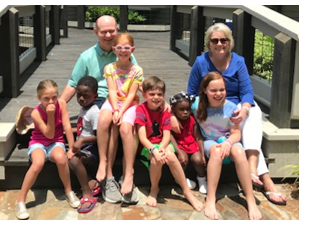 In August 2013, Jim began his proton therapy treatment at UFHPTI. “It was one of the most wonderful experiences of my life,” Jim shared. “Great doctors, nurses, technicians and support personnel who all seemed to really care about each patient. I played a lot of golf and met many new friends.”
In August 2013, Jim began his proton therapy treatment at UFHPTI. “It was one of the most wonderful experiences of my life,” Jim shared. “Great doctors, nurses, technicians and support personnel who all seemed to really care about each patient. I played a lot of golf and met many new friends.”
Jim, 67, still works, plays golf, travels with his wife “any chance we get,” and visits with his grandchildren often. “I feel great; I have no side effects from my treatment; and my latest PSA was low,” Jim said. He loves talking about proton therapy and sharing his experience with others.
Photo: Jim, his wife Renee, and six of their 10 grandchildren!
New Brain Teaser
What nine-letter word remains a valid word as each of its letters is successively removed?
This one was sent to us by a BOB member. We thought it was great! If you think you have a good brain teaser for our newsletter, please send it in!
Send your brain teaser answer to [email protected] for a chance to win a signed copy of Bob Marckini’s NEW second edition book, You Can Beat Prostate Cancer.
 Don’t Mess with Old People
Don’t Mess with Old People
The old lady handed her bank card to a bank teller and said, “I’d like to withdraw $10.”
The teller told her, “For withdrawals less than $100 please use the ATM.”
The old lady wanted to know why.
The teller returned her bank card and said irritably, “These are the rules. Please leave if there’s no other matter – there’s a line of customers behind you.”
The old lady remained silent for a few seconds, then handed the card back to the teller and said, “Please help me withdraw all the money I have.”
The teller was astonished when she checked the account balance. She nodded her head, leaned down, and respectfully said, “You have $300,000 in your account and the bank doesn’t have that much cash. Could you make an appointment and come back tomorrow?”
The old lady then asked how much she could withdraw immediately. The teller told her any amount up to $3,000.
“Well, please let me have $3,000 now,” she said. The teller humbly and respectfully handed $3,000 to her. The old lady put $10 in her purse and asked the teller to deposit $2990 back into her account.
The moral of this story: Don’t mess with old people. They spent a lifetime learning their skills.

Quote of the Month: "It's not your blood, your pedigree, or your college degree that matters. It's what you do with your life that counts." —Millard Fuller



.jpg) As the end of the year draws near, we’d like to take this opportunity to thank you.
As the end of the year draws near, we’d like to take this opportunity to thank you.
You – the one reading this. Thank you. You’re the reason we spend every day working on this newsletter. To keep you informed, we research subject matter; review potential content; discuss format; write abstracts; Photoshop graphics; edit and review … and then start all over again in an effort to deliver to you the most valuable, timely, and interesting information we can find on prostate cancer, proton therapy, and general health issues – not to mention funny jokes and random facts.
We hope you read each issue and talk about it with your family. We hope you forward it to friends, acquaintances, and anyone you think may benefit from the information. We hope you print it out and put it in your neighbor’s Christmas stocking …
We’re also thankful for all the feedback we receive – we love to know what you think. And we’re grateful for the opportunity to share what we learn with you. Our passion for helping people find their way to proton therapy is strong and it’s constant – and with this newsletter, and the support of you – our readers – we’re helping people access what we believe is the very best cancer treatment in the world.
Many of our members have also taken time out of their busy schedules to talk to others about their experience with proton therapy. Hundreds of you volunteer to be contacted by newly diagnosed men and their family members. Many of you also write letters, op-eds, blogs, Facebook posts, Twitter posts, and comments and reviews in support of proton therapy in other various media outlets. Thank you.
Some of you have contributed to our newsletter, thoroughly analyzing technical articles, reviewing books that may be valuable to our readers; allowing us to re-print interesting articles you’ve written for other publications; contributing your own personal stories, photos and videos. One of you takes hours out of every month to edit our 20-plus page newsletter! Your actions inspire and motivate us. Thank you.
Many of you have also selflessly dug deep into your own pockets and contributed financially to proton research. You understand that research is vital to advancing the effectiveness of proton therapy and setting new standards for treating and curing many types of cancer and other health issues. Your support ensures the continuity of basic and clinical, life-saving research. Thank you for the effort you take; the time you spend; and the money you spare to ensure others can access proton therapy.
Our friends in law – those who formed the Proton Therapy Law Coalition – help coordinate and unify proton therapy providers, patient advocates, and attorneys to fight health insurance denials of proton therapy. The folks at the National Association for Proton Therapy (NAPT) and representatives from many of the proton centers also share information on insurance strategies and patient success stories. Thank you. You help us become a better resource to our members and prospective proton patients.
NAPT also relays critically important information to all their members during multiple conferences over the course of a year. Another huge champion for proton therapy – the Alliance for Proton Therapy Access – has hounded the press and provided timely information and simple ways to connect with state representatives on the critical importance of proton therapy and insurance coverage. Our affiliation with these organizations builds us up and gives us the tools to fight harder for access to proton therapy. Thank you.
The COMPPARE trial team has gone above and beyond to push this important study forward, working to gain approvals from the institutional review board, get sites registered and patients enrolled, launch a newsletter, educate its stakeholders and find and take part in relevant outreach activities. We’re honored and excited to be a part of this effort, and believe it will mean big, positive changes for proton therapy – and thousands and thousands of cancer patients. Thank you to the COMPPARE team for your tireless efforts to save lives and improve the quality of life for men being treated for prostate cancer.
Finally, thank you to Loma Linda University Health. Thank you to the late Dr. James Slater, whose determination to improve the quality of life for patients undergoing cancer treatment inspired the use of proton therapy for patient care and the development of the world’s first hospital-based proton treatment center at Loma Linda University Health. And thank you to our family at the Loma Linda University Cancer Center who support us in more ways than we have time or space to mention. We’re indebted to you for your unwavering commitment to patients, proton therapy, and the BOB. Without you, the BOB wouldn’t exist.
We wish you all a happy and safe holiday season and a new year filled with peace, joy, and good health.
Bob Marckini and Deb Hickey
To print the BOB Tales newsletter or view the newsletter with a larger font size, click here for the PDF file.
NO MEDICAL ADVICE: Material appearing here represents opinions offered by non-medically-trained laypersons. Comments shown here should NEVER be interpreted as specific medical advice and must be used only as background information when consulting with a qualified medical professional.
